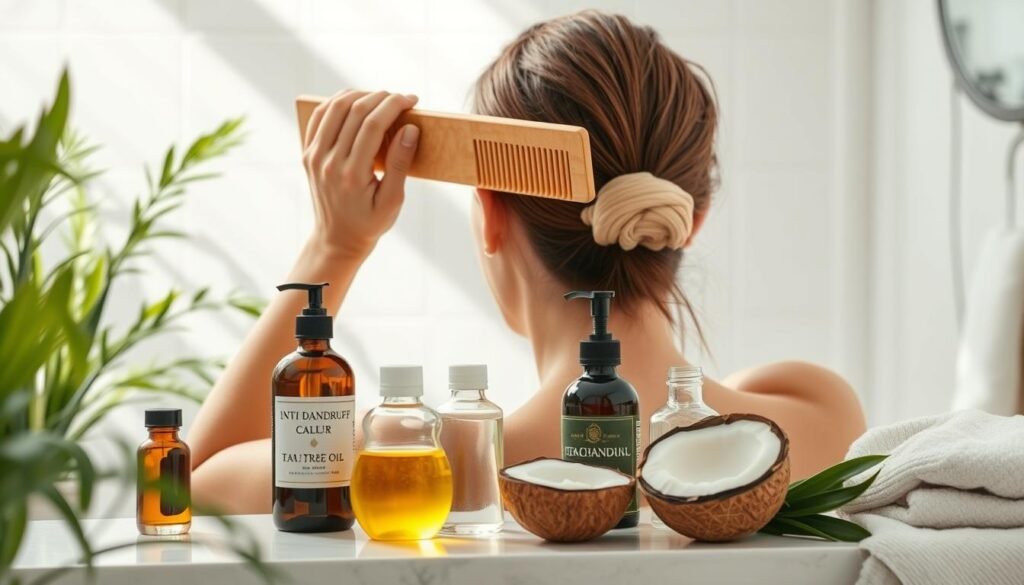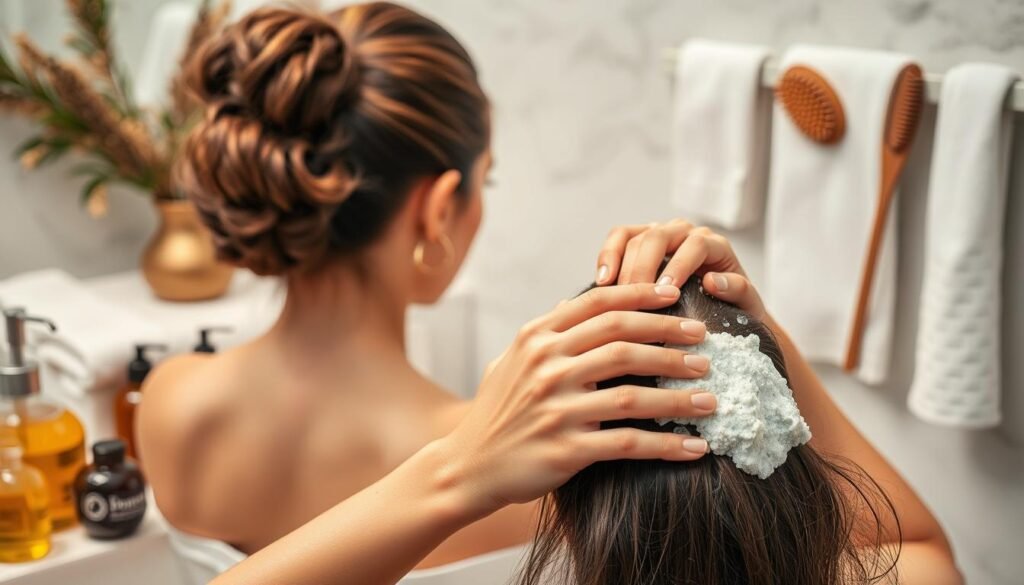Have you thought that washing your hair often might make dandruff worse? It’s vital to keep your scalp healthy to fight dandruff. However, figuring out the best scalp cleaning routine is tricky. Your hair type, lifestyle, and specific scalp needs matter a lot. Here, we’ll explore the recommended frequency for scalp cleansing to prevent dandruff effectively, with advice from experts.
Finding the right balance in scalp cleansing is crucial for healthy hair and can reduce dandruff. For tips on effective cleansing and its benefits, click here.
Key Takeaways
- It’s important to cleanse your scalp regularly to prevent dandruff.
- Your hair type and how you live can affect how often you need to wash.
- Follow expert advice to find the best cleansing schedule for you.
- A healthy scalp helps prevent dandruff and improves hair health.
- Custom cleansing plans can improve your scalp and decrease dandruff.
The Importance of Scalp Cleansing
Keeping your scalp clean is key to having healthy skin on your head. It helps get rid of oil, dead skin, and leftover product. If you don’t clean your scalp, you might get itchy and inflamed, and dandruff could appear.
This routine is more than just cleanliness; it affects how your hair grows and breathes. So, taking care of your scalp is super important for its overall health.
Cleaning your scalp regularly has many pluses. Some of the biggest benefits are:
- Improved scalp respiration: A clean scalp lets your skin breathe better, which is great for its health.
- Enhanced hair growth: By washing your scalp, you boost blood flow. This means more nutrients for your hair roots.
- Reduced dandruff occurrences: If you keep your scalp clean, you’re less likely to get dandruff, studies show.
Knowing these scalp cleansing benefits highlights why taking care of your scalp is a must. Cleanliness helps avoid scalp issues down the line. A good scalp care routine means a healthy, flake-free head of hair.
Understanding Dandruff: Causes and Symptoms
Dandruff can really bother a lot of people. Knowing why it happens and what it looks like is key to dealing with it. Things like seborrheic dermatitis, a skin issue that causes red and itchy spots, are often to blame. Fungal infections, especially by Malassezia yeast, are also a big cause.
Finding out if you have dandruff can be tough. It starts with a little flaking that can get worse. You might see a lot of flakes, feel itchy, and see redness. Knowing these signs early on helps to tackle the issue before it gets bad.
There’s a difference between a little and a lot of dandruff. A bit of flaking can often be solved with regular washing and using lotion. But if it’s bad, you might need special shampoos or even see a doctor.
Learning about these factors is important. It helps you manage dandruff better and take good care of your scalp.
How Frequency Affects Dandruff
The frequency of scalp cleansing is key in controlling dandruff. Not washing enough can cause buildup and more oil, making dandruff worse. Regular cleaning of the scalp has shown to help keep it healthy.
Washing too much has its downsides too. It can remove important oils, leading to a dry scalp which makes flaking worse. It’s important to find the right balance. Trichologists have found that the best washing routine depends on your scalp and hair type. For example, if your scalp is oily, you might need to wash it more often.
A study showed people who washed their hair five to six times a week were happy with their scalp and hair condition. Another study found washing every day was better than once a week. These studies show that good scalp hygiene makes for healthier scalp and hair.
In the end, washing too little or too much can harm your scalp. Adjusting how often you wash your hair can lead to a healthier scalp and lessen dandruff. For more information, check out this detailed study on how scalp cleanliness affects hair health here.
Best Practices for Scalp Cleansing
Having a healthy scalp is key to fighting off dandruff. The steps you take in caring for your scalp really matter. Start by picking a shampoo that fits your scalp’s needs. Choosing a gentle, moisturizing shampoo helps clean your scalp well and reduces irritation.
Be mindful of the water temperature when you’re washing your hair. Lukewarm water is best because it opens the hair cuticles. This action allows the shampoo to penetrate better. Try to stay away from hot water since it can take away your scalp’s natural oils and lead to dryness.
Adding a massage to your shampoo routine can boost blood flow. This helps spread the shampoo evenly and cleans deeply. Regular scalp care like this can improve your scalp’s health over time.
Don’t forget to condition your hair after shampooing. Pick a conditioner that nourishes without making your roots greasy. Make sure to rinse it out completely. Leaving conditioner in your hair can cause buildup and worsen dandruff.
Home remedies offer extra help for your scalp. Ingredients like lemon and tea tree oil can be good for scalp health. Adding these to your scalp care can lessen dandruff.

To wrap it up, sticking to a solid scalp care routine is key to a healthy scalp. For more tips, look at the guidelines on effective scalp cleaning.
| Practice | Description |
|---|---|
| Choose the Right Shampoo | Select a gentle, sulfate-free formula tailored to your scalp type. |
| Water Temperature | Use lukewarm water to enhance cleansing and maintain moisture. |
| Scalp Massage | Gently massage during washing to improve circulation and product absorption. |
| Conditioning | Always follow up with a conditioner focused on hydration without residue. |
| Natural Remedies | Consider adding lemon or tea tree oil to your routine for additional benefits. |
Ways to Maintain Scalp Health
A healthy scalp prevents dandruff and boosts overall scalp health. To have vibrant hair and a comfy scalp, practice good scalp care. What you eat affects your scalp’s health. Foods high in omega-3 fatty acids, like salmon and flaxseeds, help keep your skin moist. Drinking enough water also cuts down on dryness, which can cause dandruff.
Scalp massages are great too. They boost blood flow, helping nutrients reach your hair roots and improving your scalp’s health. Managing stress is also key. Since stress can bring on scalp issues, try to relax with activities like meditation or yoga.
Getting good sleep is important for your scalp and hair. A solid sleep routine helps your body mend and refresh, which is good for your scalp. Changing some of your daily habits can make a big difference in your scalp’s condition, giving you healthier hair. For more info and tips, check out Healthline.
| Healthy Practices | Benefits |
|---|---|
| Omega-3 Rich Diet | Improves moisture levels |
| Regular Hydration | Reduces dryness |
| Scalp Massages | Stimulates blood circulation |
| Stress Management | Reduces triggers for scalp issues |
| Quality Sleep | Aids in regeneration and repair |
Healthy Scalp Tips for Dandruff Prevention
Maintaining a healthy scalp is key to stopping dandruff. Making small changes to your daily habits can really help. Here are some easy tips for dandruff prevention that anyone can use.
- Use a humidifier in dry places. It keeps your scalp moist, which can reduce dryness and itching.
- Pick hair products without harsh chemicals. Things like sulfates and parabens can make scalp problems worse.
- Change your pillowcases often. Clean pillowcases help avoid contact with oils and bacteria, keeping your scalp healthier.
- Try scalp massages when you care for your hair. They help blood flow better, which is good for hair growth and scalp health.
- Drink a lot of water to stay hydrated. Being well-hydrated is good for your scalp and skin too.
Experts always talk about the importance of a healthy scalp to prevent dandruff. Hearing stories from people shows that these tips work. Just a few changes in how you look after your hair can make a big difference in dealing with scalp issues.

Cleanse Your Scalp to Prevent Dandruff
Cleansing your scalp well is important to keep it healthy and dandruff-free. Everyone should find a routine that fits their scalp type. For instance, if your scalp is oily, you might need to wash it often. But if it’s dry, less frequent cleansing could be better. Finding what works best for your scalp is crucial.
Using good anti-dandruff shampoos and treatments is also key. Studies show that certain ingredients, like zinc pyrithione and salicylic acid, are effective against dandruff. They also help soothe the scalp. Using these products regularly is vital for a good anti-dandruff plan.
To plan your cleansing routine, here are some tips:
| Scalp Type | Recommended Cleansing Frequency | Product Suggestions |
|---|---|---|
| Oily | 2-3 times per week | Neutrogena Anti-Residue Shampoo, Head & Shoulders Classic Clean |
| Dry | Once a week | Paul Mitchell Tea Tree Special Shampoo, Dove Derma365 Anti-Dandruff Shampoo |
| Normal | 1-2 times per week | Aveda Scalp Benefits Shampoo, Biolage Scalpsync Shampoo |
Sticking to this customized plan is essential for lasting results. Consistent cleansing does more than prevent dandruff. It also improves your hair’s health.
Scalp Cleansing Techniques: What Works?
Learning about effective scalp cleansing techniques can really boost your hair’s health. It can even keep dandruff away. There are many ways to cleanse, each with its own perks. Starting with an oil-based cleanser and following up with a water-based shampoo is a smart move. This double cleansing method gets rid of both product buildup and extra oil.
Exfoliating your scalp is also key. It helps get rid of dead skin cells and boosts scalp blood flow. Using scalp scrubs and brushes can make it simple to cover your entire scalp. Research shows these cleansing methods for dandruff can make your scalp health better.
Don’t forget about scalp massages. They’re not just relaxing—they also help with blood circulation, making your scalp healthier. Adding natural oils like tea tree or coconut oil during massages can really step up the cleansing game.
Experts often suggest specific products for different scalp issues. For deep cleaning, detox masks with baking soda or micellar water work wonders. Looking into scalp detoxing techniques is a smart way to know what’s best for you.

| Technique | Description | Benefits |
|---|---|---|
| Double Cleansing | Using an oil-based cleanser followed by a shampoo. | Removes buildup and offers a thorough cleanse. |
| Exfoliation | Removing dead skin with scalp scrubs or brushes. | Improves circulation and cleanses deeply. |
| Scalp Massage | Using fingers or tools to massage oils into the scalp. | Promotes relaxation and stimulates blood flow. |
| Detox Masks | Applying masks with ingredients like baking soda. | Provides intense purification for the scalp. |
Finding the best mix of these techniques can make your scalp care routine just right for you. Trying out various methods and sticking to them can help you achieve healthier hair and a comfy scalp.
Creating a Scalp Care Routine
Creating a special scalp care routine is key to keeping a healthy scalp and avoiding dandruff. It’s important to pick a routine that suits your specific needs. This includes choosing how often to wash your hair and the right way to do it. Your routine should have gentle shampoos and exfoliating treatments for a healthy scalp.
When you personalize your scalp care, watch how your scalp reacts to different products. Using oils like tea tree or argan oil can help keep your scalp moisturized and comfortable. A scalp brush or massage tool can boost blood flow and remove buildup that causes flakes. It’s important to change your routine based on lifestyle, weather, or new hair products.
Your scalp care routine should change as your scalp’s condition changes. Paying close attention to your scalp’s needs helps maintain balance and health. This makes fighting dandruff easier over time. By adjusting, you can ensure your scalp stays healthy no matter the conditions.